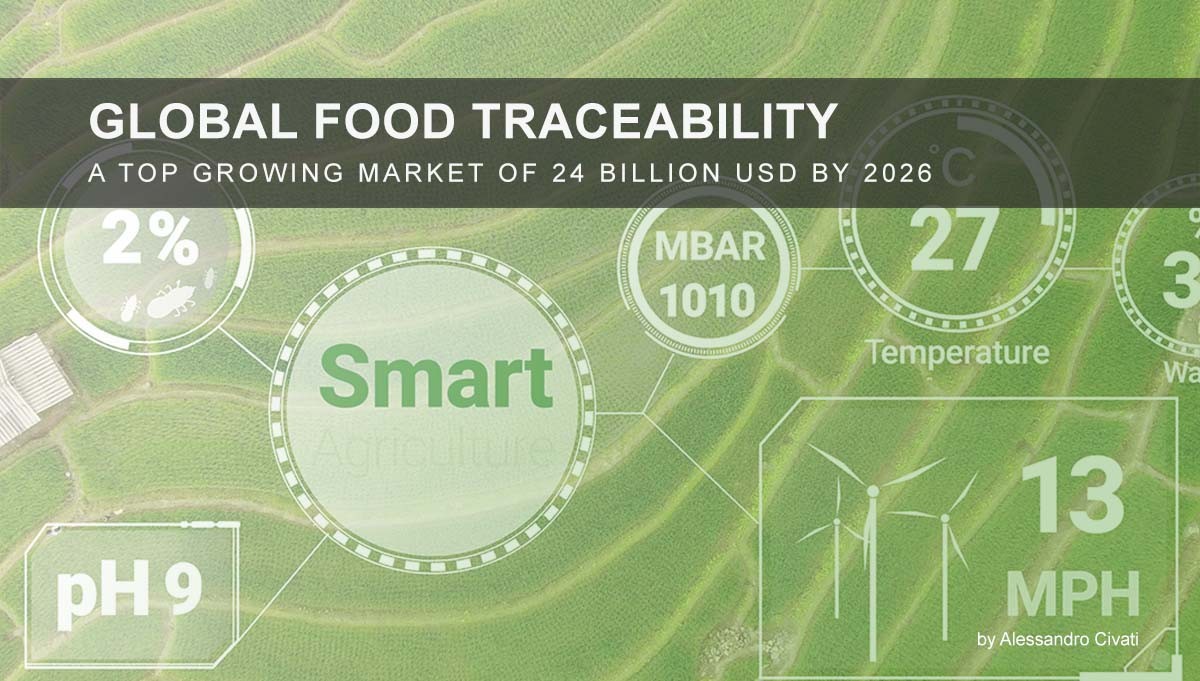The global food traceability market is steadily growing as consumers seek to know the source and origin of their food items. Food traceability will help identify how and where food and food items were contaminated.
In essence, food traceability allows food makers to document and track the progress of a product through different phases of the food production process. The food traceability technology can track food manufacturing from processing, handling, and distribution processes.
The traceability systems rely on data and operations to keep track of critical and other desired information about a product. The food traceability systems have two distinct components – tracking and tracing. Tracing is the component that creates records of the history of food products throughout the entire food chain. Tracking is the component that confers the ability to determine a product’s final destination by following the food product’s path from manufacture to sale.
Food traceability involves monitoring the movement of food and associated goods right from manufacturing through processing to distribution. The process of food production follows several steps that start with seed and fertilizer selection, farming practices, harvesting, storage, processing, shipping, and sale at the retail level. There are many dangers throughout all these processes, including adulteration and contamination of food items. Food traceability systems aid in the identification, data collection, data storage, linking, and verification of information records. The primary goal of food traceability systems is to protect consumer health by safeguarding food safety and preventing food-borne diseases.
Some of the major market players in the food traceability industry include:
- Bar Code Integrators
- Bext360
- Bio-Rad Laboratories Inc.
- Carlisle
- C.H. Robinson
- Cognex
- Covectra
- Crest Solutions
- Food Forensics
- FoodLogiq
- Honeywell International Inc.
- Mass Group
- Merit-Trax
- OPTEL GROUP
- Safe Traces
- SGS SA
- IMAGE
- Source Trace
- TE-Food
- Trace Global
- Trace One
- Vermeer
- Zebra Technologies
Market Dynamics
Technologically advanced nations such as the USA, the UK, Japan, and other EU nations lead the charge and drive the food traceability industry. It has also seen end-users in developing countries become increasingly aware of food safety and adopting food traceability technologies.
Companies in the food production and processing sector are currently maintaining solid business frameworks that facilitate seamless operation and keep optimal inventory levels. These frameworks are increasing the need for food traceability technologies to track the source and entire process of food items. Growth in the global food traceability market is driven by legislative frameworks, standardizations, and certifications. Governments in developed and developing countries are pushing for compliance with food safety legislation and regulations to push forward market expansion.
One of the factors driving the global food traceability market is the advent of new and innovative food traceability technologies. The new technologies are aiding in extending the application base and helping build presence across different sectors and around the world. Major players have made a concerted effort in the industry to create new and widely acceptable technologies.
The global food traceability market can be segmented as follows:
1 – By Equipment:
- PDA with GPS
- Thermal Printers
- 2D & 1D Scanners
- Tags & Labels
- Sensors
- Others
2 – By Technology:
- RFID/RTLS
- GPS
- Barcode
- Infrared
- Biometrics
3 – By Application:
- Meat & Livestock
- Fresh Produce & Seeds
- Dairy
- Beverages
- Fisheries
- Others
4 – By End User:
- Food Manufacturers
- Warehouse/Pack Farms
- Food Retailers
- Defense & Security Departments
- Government Departments
- Others
Competitive advantage, food contamination tracing, brand loyalty, information flow upstream and downstream of the supply chain, and product recalls driving the food traceability market.
Rising consumer awareness is yet another factor driving the global food traceability market. Food safety is now on the top of the mind of consumers amid increasing cases of food contamination incidences.
Food traceability is finding new prospects in steadily growing economies like China, India, and Brazil. The use of barcodes, data matrix codes, dotcodes, and QR codes is becoming a requirement on packaging for beverages, foods, and pharmaceuticals leading to rising demand for barcode scanners and other traceability solutions to extract information about that specific item.
The expansion of the traceability market is also significantly impacted by the expensive costs of food traceability equipment and privacy concerns. However, advancements in food traceability are allowing widespread adoption. Barcodes are the most commonly used technology in the food traceability industry due to their cost-effectiveness. The technology uses a Global Trade Item Number (GTIN) that comprises a firm prefix from GS1. GS1 is a non-profit organization that develops and maintains demand and supply chain standards and a unique item reference number typically read by universal product bar codes or human-readable codes. We even have DNA barcoding that is effective in ascertaining the biological status of the organism, tracking changes, and detecting food contamination to safeguard consumer health.
Mobile software development companies have created software that allows mobile devices to interface with scanners. Mobile technology is lowering and eliminating the cost of superfluous hardware acquisition, allowing more and more businesses to adopt food traceability.
Projected Trends
Food is currently being sourced worldwide, presenting both opportunities and challenges for the food traceability industry. Changing consumption habits driven by increased awareness about healthy foods and beverages will expand food traceability. According to predictions, the Asia-Pacific region will grow at a substantial rate from 2021 to 2028. The general population in countries like China, India, and South Korea is becoming increasingly knowledgeable and aware of their food choices. In addition, the governments in the countries are adopting strict traceability systems, which will foster rapid growth of the global food traceability market.
Author: Alessandro Civati
Blockchain ID: https://x88.life/5v1NrbaSHJ







